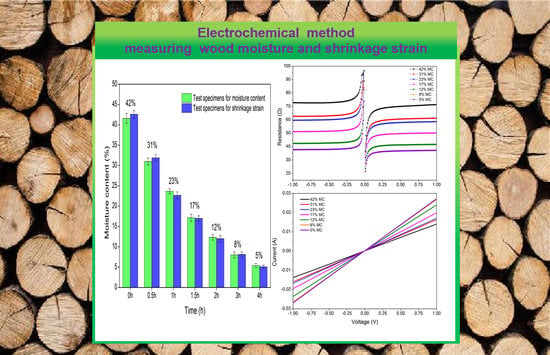Determination of Moisture Content and Shrinkage Strain during Wood Water Loss with Electrochemical Method
Abstract
:1. Introduction
2. Materials and Methods
2.1. Preparation of the Samples and Testing Equipment
2.2. Determination of MC and Shrinkage Strain
3. Results and Discussion
3.1. The MC of Test Specimens
3.2. Analysis of MC Test Results
3.3. Analysis of Shrinkage Strain Test Results
4. Conclusions
Author Contributions
Funding
Institutional Review Board Statement
Informed Consent Statement
Data Availability Statement
Conflicts of Interest
References
- Baettig, R.; Rémond, R.; Perré, P. Measuring moisture content profiles in a board during drying: A polychromatic X-ray system interfaced with a vacuum/pressure laboratory kiln. Wood Sci. Technol. 2006, 40, 261–274. [Google Scholar] [CrossRef]
- Yu, L.; Hao, X.; Cai, L.; Shi, S.Q.; Jiang, J.; Lu, J. An Investigation of Moisture Gradient in Wood during Drying Using X-ray Radiation and Numeric Methods. For. Prod. J. 2014, 64, 199–205. [Google Scholar] [CrossRef]
- Watanabe, K.; Saito, Y.; Avramidis, S.; Shida, S. Non-destructive Measurement of Moisture Distribution in Wood during Drying Using Digital X-ray Microscopy. Dry. Technol. 2008, 26, 590–595. [Google Scholar] [CrossRef]
- Tanaka, T.; Avramidis, S.; Shida, S. Evaluation of moisture content distribution in wood by soft X-ray imaging. J. Wood Sci. 2009, 55, 69–73. [Google Scholar] [CrossRef]
- Watanabe, K.; Lazarescu, C.; Shida, S.; Avramidis, S. A Novel Method of Measuring Moisture Content Distribution in Timber During Drying Using CT Scanning and Image Processing Techniques. Dry. Technol. 2012, 30, 256–262. [Google Scholar] [CrossRef]
- Lindgren, O.; Seifert, T.; Du Plessis, A. Moisture content measurements in wood using dual-energy CT scanning—A feasibility study. Wood Mater. Sci. Eng. 2016, 11, 312–317. [Google Scholar] [CrossRef]
- Rosenkilde, A.; Glover, P. High Resolution Measurement of the Surface Layer Moisture Content during Drying of Wood Using a Novel Magnetic Resonance Imaging Technique. Holzforschung 2002, 56, 312–317. [Google Scholar] [CrossRef]
- Xu, K.; Lu, J.; Gao, Y.; Wu, Y.; Li, X. Determination of moisture content and moisture content profiles in wood during drying by low-field nuclear magnetic resonance. Dry. Technol. 2017, 35, 1909–1918. [Google Scholar] [CrossRef]
- Fu, Z.; Zhao, J.; Yang, Y.; Cai, Y. Variation of Drying Strains between Tangential and Radial Directions in Asian White Birch. Forests 2016, 7, 59. [Google Scholar] [CrossRef] [Green Version]
- Cheng, W.; Morooka, T.; Liu, Y.; Norimoto, M. Shrinkage stress of wood during drying under superheated steam above 100 °C. Holzforschung 2004, 58, 423–427. [Google Scholar] [CrossRef]
- Peng, M.; Ho, Y.-C.; Wang, W.-C.; Chui, Y.H.; Gong, M. Measurement of wood shrinkage in jack pine using three dimensional digital image correlation (DIC). Holzforschung 2012, 66, 639–643. [Google Scholar] [CrossRef]
- Khoo, S.-W.; Karuppanan, S.; Tan, C.-S. A Review of Surface Deformation and Strain Measurement Using Two-Dimensional Digital Image Correlation. Metrol. Meas. Syst. 2016, 23, 461–480. [Google Scholar] [CrossRef]
- Mallet, J.; Kalyanasundaram, S.; Evans, P.D. Digital Image Correlation of Strains at Profiled Wood Surfaces Exposed to Wetting and Drying. J. Imaging 2018, 4, 38. [Google Scholar] [CrossRef] [Green Version]
- Han, Y.; Park, Y.; Park, J.-H.; Yang, S.-Y.; Eom, C.-D.; Yeo, H. The shrinkage properties of red pine wood assessed by image analysis and near-infrared spectroscopy. Dry. Technol. 2016, 34, 1613–1620. [Google Scholar] [CrossRef]
- Huang, Y.; Peng, L.; Liu, Y.; Zhao, G.; Chen, J.Y.; Yu, G. Biobased Nano Porous Active Carbon Fibers for High-Performance Supercapacitors. ACS Appl. Mater. Interfaces 2016, 8, 15205–15215. [Google Scholar] [CrossRef]
- Pulido, Y.F.; Blanco, C.; Anseán, D.; García, V.M.; Ferrero, F.; Valledor, M. Determination of suitable parameters for battery analysis by Electrochemical Impedance Spectroscopy. Measurement 2017, 106, 1–11. [Google Scholar] [CrossRef] [Green Version]
- Yang, J.; Chen, J.; Zhou, Y.; Wu, K. A nano-copper electrochemical sensor for sensitive detection of chemical oxygen demand. Sens. Actuators B Chem. 2011, 153, 78–82. [Google Scholar] [CrossRef]
- Wang, Y.-C.; Su, M.; Xia, D.-H.; Wu, Z.; Qin, Z.; Xu, L.; Fan, H.-Q.; Hu, W. Development of an electrochemical sensor and measuring the shelf life of tinplate cans. Measurement 2018, 134, 500–508. [Google Scholar] [CrossRef]
- Arellano-Pérez, J.; Negrón, O.R.; Jiménez, R.E.; Gómez-Aguilar, J.; Uruchurtu-Chavarín, J. Development of a portable device for measuring the corrosion rates of metals based on electrochemical noise signals. Measurement 2018, 122, 73–81. [Google Scholar] [CrossRef]
- Ma, C.; Wang, Z.; Behnamian, Y.; Gao, Z.; Wu, Z.; Qin, Z.; Xia, D.-H. Measuring atmospheric corrosion with electrochemical noise: A review of contemporary methods. Measurement 2019, 138, 54–79. [Google Scholar] [CrossRef]
- Salimi, A.; Kavosi, B.; Navaee, A. Amine-functionalized graphene as an effective electrochemical platform toward easily miRNA hybridization detection. Measurement 2019, 143, 191–198. [Google Scholar] [CrossRef]
- Glass, S.V.; Zelinka, S.L. Moisture relations and physical properties of wood. In Wood Handbook: Wood as an Engineering Material; United States Department of Agriculture Forest Service, Forest Service, Forest Products Laboratory: Madison, WI, USA, 2021. [Google Scholar]
- Brischke, C.; Rapp, A.O.; Bayerbach, R. Measurement system for long-term recording of wood moisture content with internal conductively glued electrodes. Build. Environ. 2008, 43, 1566–1574. [Google Scholar] [CrossRef]
- Brischke, C.; Lampen, S.C. Resistance based moisture content measurements on native, modified and preservative treated wood. Holz Als Roh- Werkst. 2014, 72, 289–292. [Google Scholar] [CrossRef]
- Barański, J.; Suchta, A.; Barańska, S.; Klement, I.; Vilkovská, T.; Vilkovský, P. Wood Moisture-Content Measurement Accuracy of Impregnated and Nonimpregnated Wood. Sensors 2021, 21, 7033. [Google Scholar] [CrossRef] [PubMed]
- Davidson, R. The effect of temperature on the electrical resistance of wood. For. Prod. J. 1958, 8, 160–164. [Google Scholar]
- Stamm, A.J. The Electrical Resistance of Wood as aMeasure of Its Moisture Content. Ind. Eng. Chem. 1927, 19, 1021–1025. [Google Scholar] [CrossRef]
- Nilsson, M. Evaluation of Three In-Line Wood Moisture Content Meters. Master’s Thesis, Luleå University of Technology, Skellefteå, Sweden, 2010. [Google Scholar]
- Stamm, A.J. Wood and Cellulose Science; Ronald Press: New York, NY, USA, 1964; 549p. [Google Scholar]
- Pang, S.; Herritsch, A. Physical properties of earlywood and latewood of Pinus radiata D. Don: Anisotropic shrinkage, equilibrium moisture content and fibre saturation point. Holzforschung 2005, 59, 654–661. [Google Scholar] [CrossRef]
- Gerhards, C.C. Effect of moisture content and temperature on the mechanical properties of wood: An analysis of immediate effects. Wood Fiber Sci. 2007, 14, 4–36. [Google Scholar]
- Hernandez, R.E.; Pontin, M. Shrinkage of three tropical hardwoods below and above the fiber saturation point. Wood Fiber Sci. 2007, 38, 474–483. [Google Scholar]
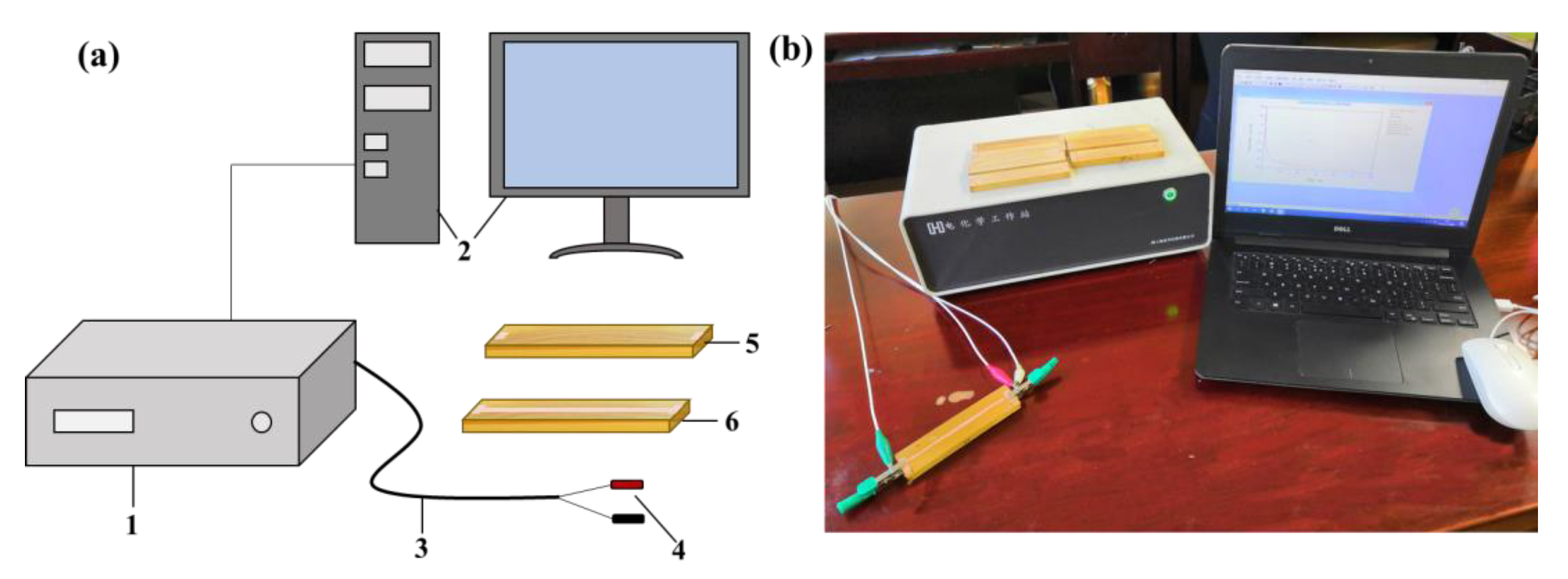
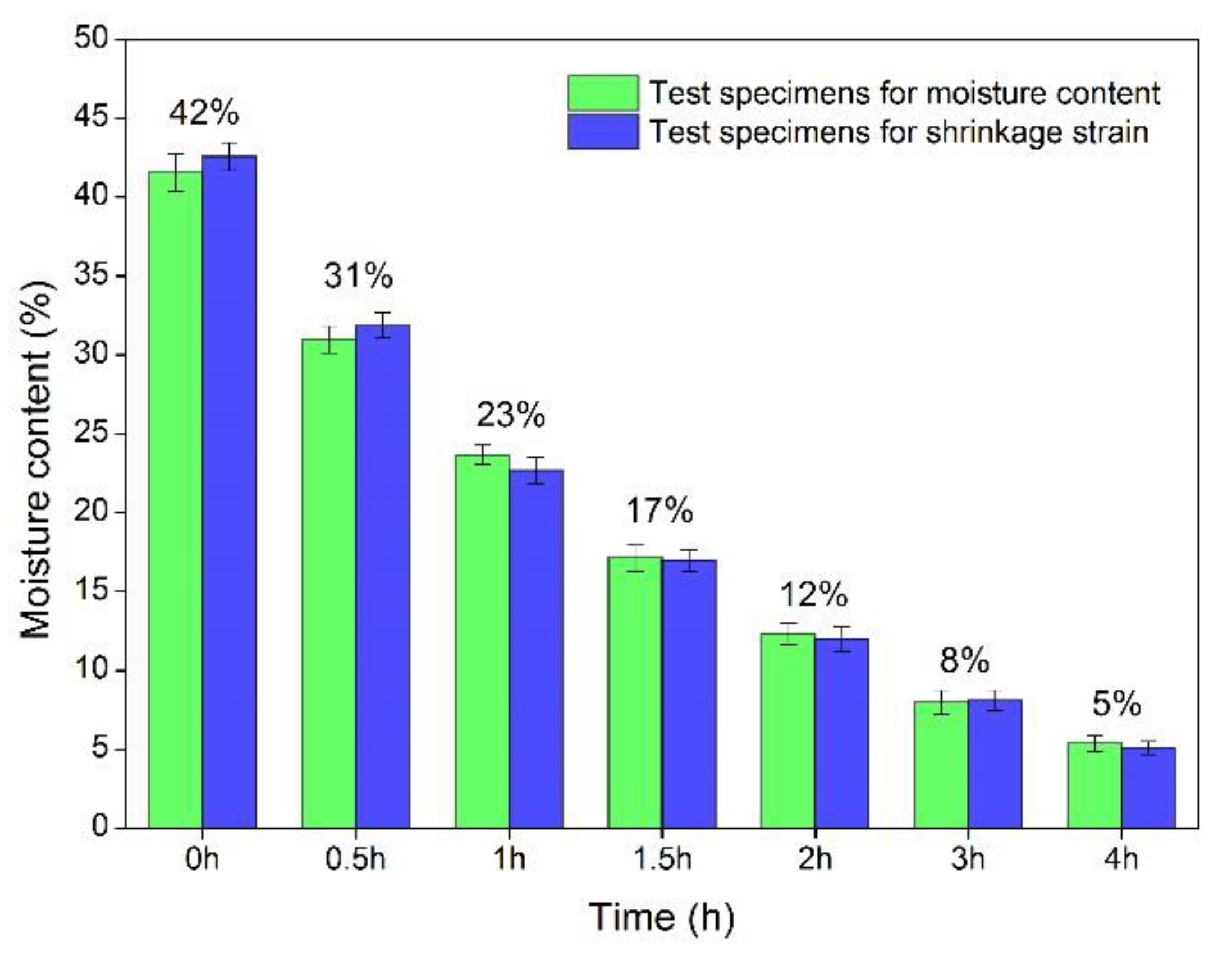
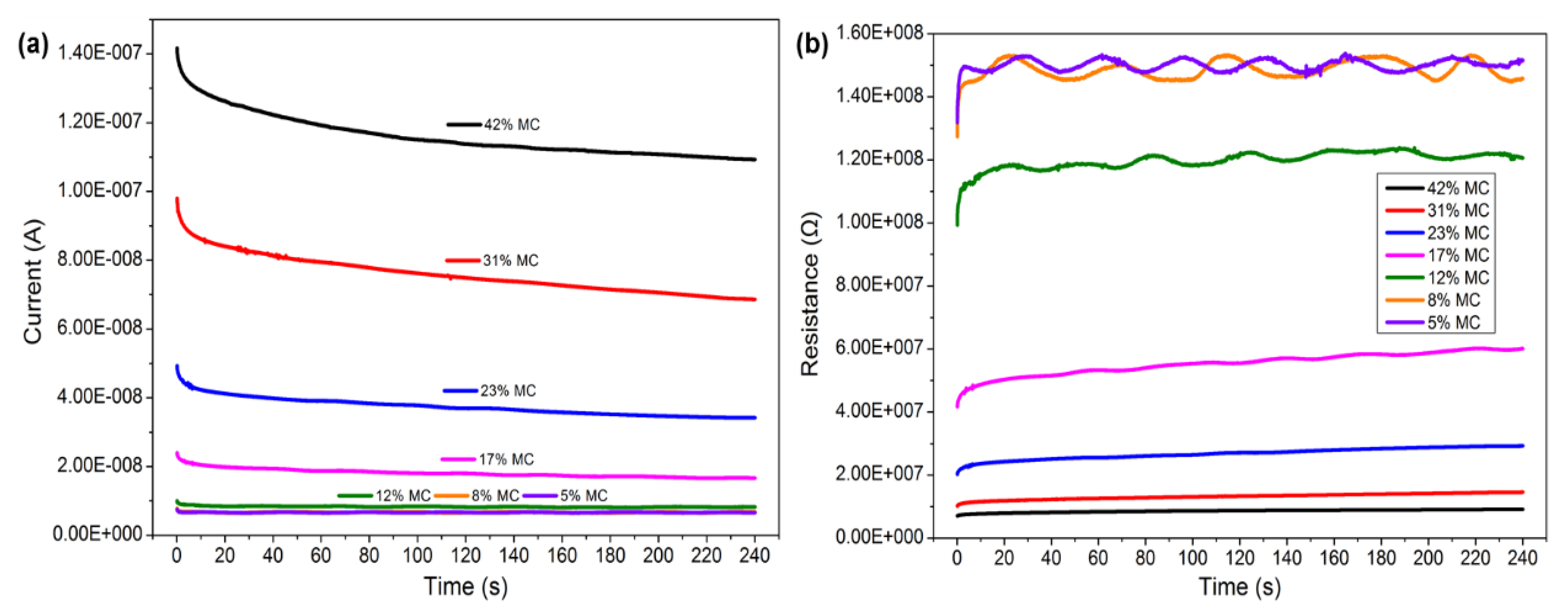
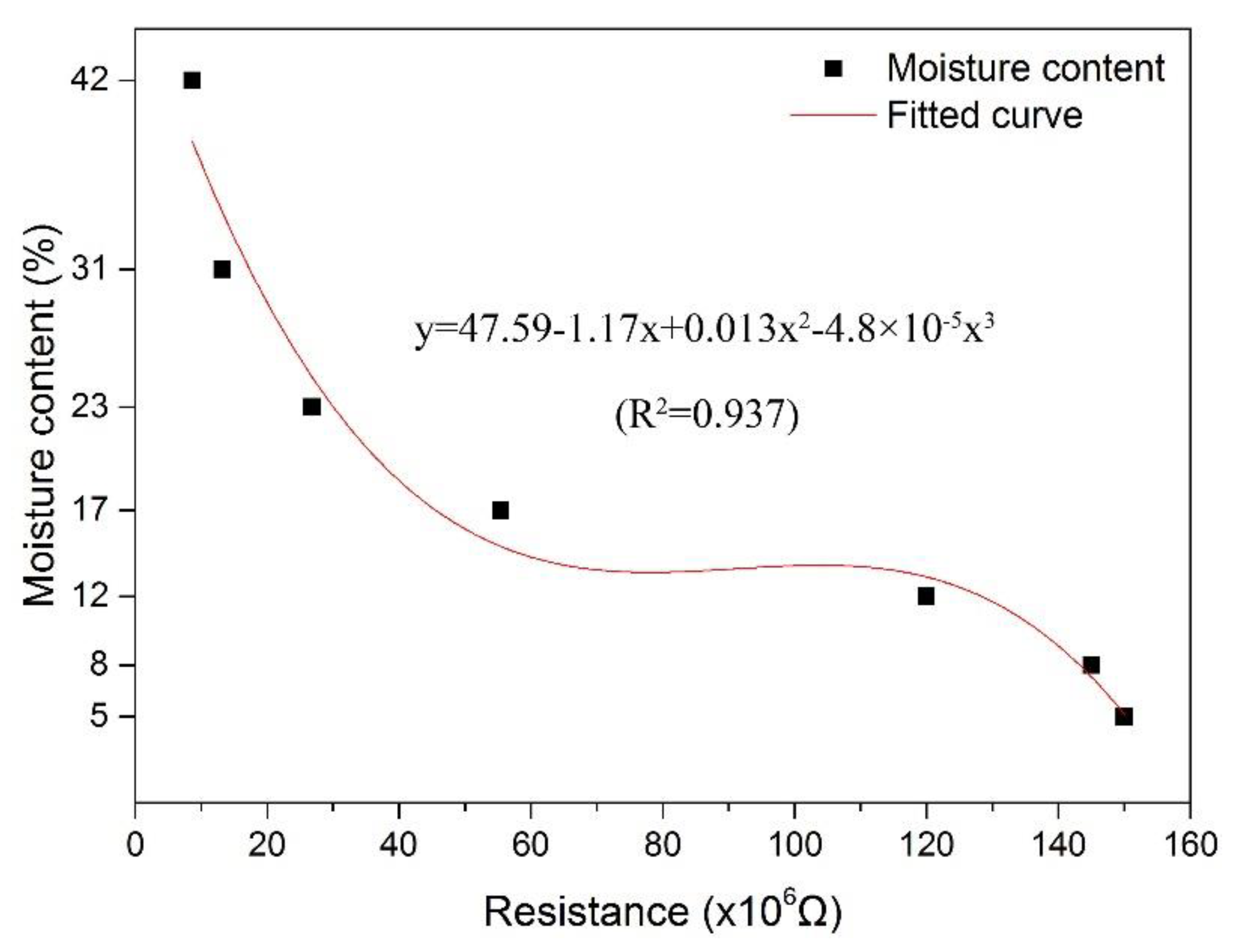

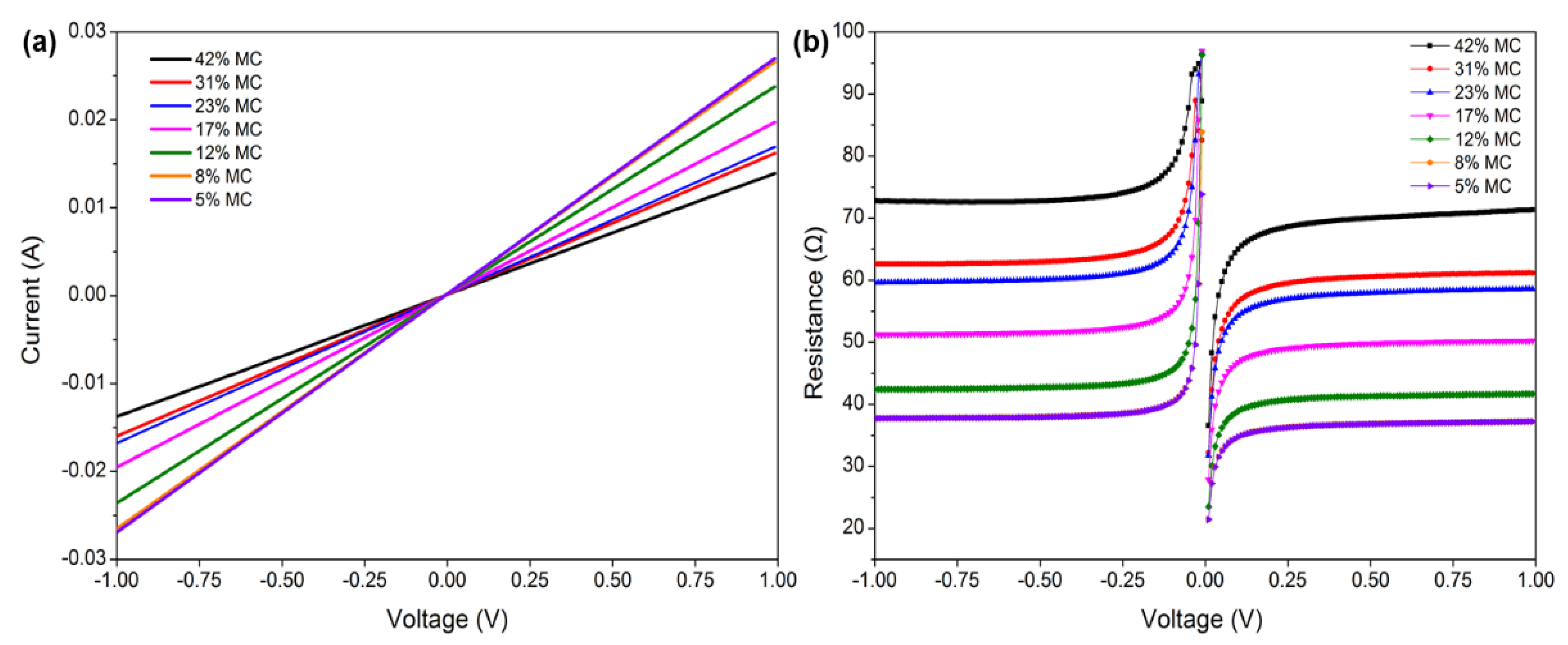
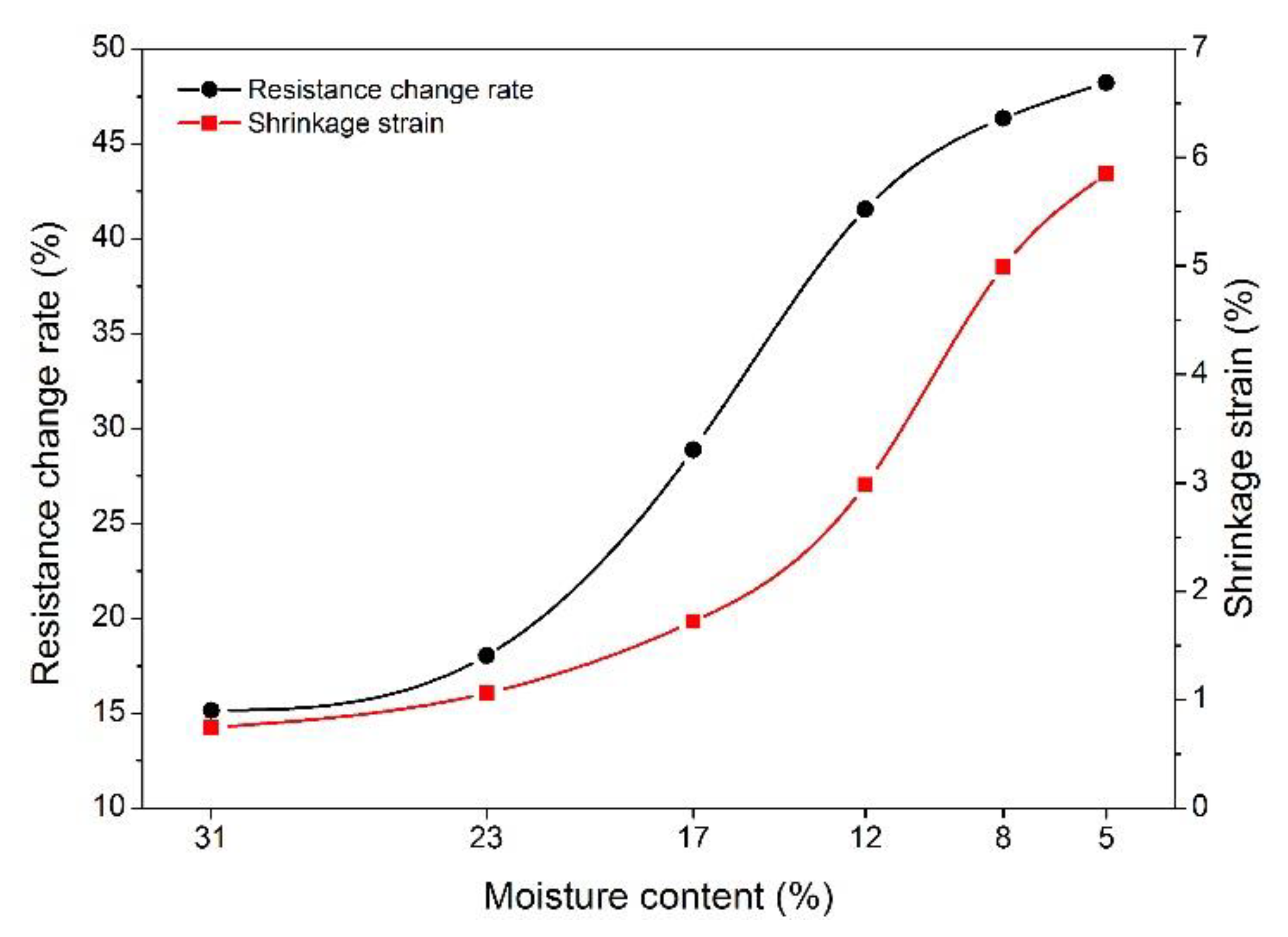
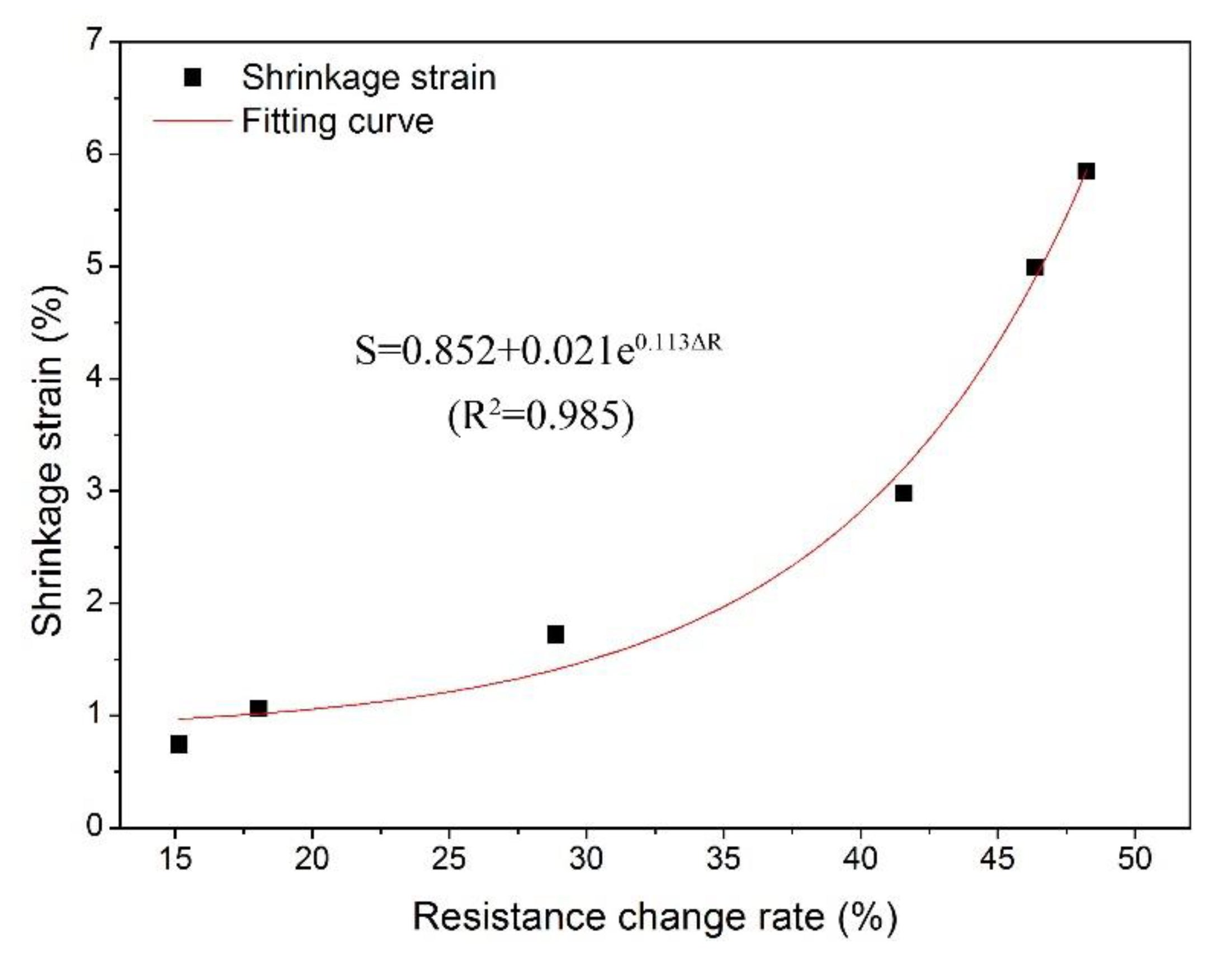
Publisher’s Note: MDPI stays neutral with regard to jurisdictional claims in published maps and institutional affiliations. |
© 2022 by the authors. Licensee MDPI, Basel, Switzerland. This article is an open access article distributed under the terms and conditions of the Creative Commons Attribution (CC BY) license (https://creativecommons.org/licenses/by/4.0/).
Share and Cite
Fu, Z.; Wang, H.; Li, J.; Lu, Y. Determination of Moisture Content and Shrinkage Strain during Wood Water Loss with Electrochemical Method. Polymers 2022, 14, 778. https://doi.org/10.3390/polym14040778
Fu Z, Wang H, Li J, Lu Y. Determination of Moisture Content and Shrinkage Strain during Wood Water Loss with Electrochemical Method. Polymers. 2022; 14(4):778. https://doi.org/10.3390/polym14040778
Chicago/Turabian StyleFu, Zongying, Hui Wang, Jingpeng Li, and Yun Lu. 2022. "Determination of Moisture Content and Shrinkage Strain during Wood Water Loss with Electrochemical Method" Polymers 14, no. 4: 778. https://doi.org/10.3390/polym14040778
APA StyleFu, Z., Wang, H., Li, J., & Lu, Y. (2022). Determination of Moisture Content and Shrinkage Strain during Wood Water Loss with Electrochemical Method. Polymers, 14(4), 778. https://doi.org/10.3390/polym14040778







